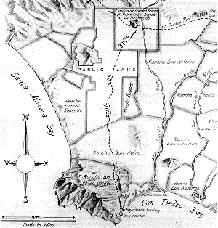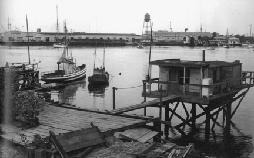 |
| ~ Los Angeles Public Library |
|
| The Land
SAN PEDRO IS LOCATED AT
THE SOUTHERN TIP OF LOS ANGELES COUNTY. Originally the territory of
the Chumash then the Tongva tribes, the first documented western
visitor was Spanish explorer, Juan Rodriguez Cabrillo who sailed into the bay in 1542 claiming territories for Spain.
In 1602, Cabrilloís countryman, Sebastian Vizcaino
sailed up the California coast. Among the many places Vizcaino left
his mark were the San Diego Bay, named for his flagship, and the
community of San Pedro, which he named upon arrival on Saint Peterís
Day.
In 1784, King Carlos III of Spain granted the
75,000-acre Los Angeles area coastal region to Juan Jose Dominguez, a
retired Spanish soldier and early California explorer. This parcel became Rancho San Pedro.
|
Family Feud
THE DOMINGUEZ LAND GRAND REMAINED INTACT
until 1822, a year after Mexican independence when Manuel Gutierrez
manager of the Dominguez estate became executor and allowed a friend,
Jose Delores Sepulveda to graze cattle on the land.
A CONTEST OF OWNERSHIP
between the official owners, the Dominguez family, and the Sepulveda
family began. In 1834, California Governor Jose Figueroa settled the
conflict with a decree to parcel the western 31,629 acres to the
Sepulveda family. This section became Rancho Palos Verdes. The
remaining 43,119 acres of Rancho San Pedro, to the east and north,
remained the property of the Dominguez heirs.
|
Terminal Island
Off the coast of San Pedro a muddy sandbar known as La Isla la Culebra Cascabel or in English, Rattlesnake Island,
piqued the interest of shipping companies. In the 1870s, the U.S. Corp
of Engineers constructed jetties, dredged the channel between the
island and San Pedro, and secured dockside-landing facilities. Loading and
unloading was now possible farther up the channel in a protected
harbor. For a time, a small community lived on stilted houses and in beach cabins. The village became known as East San Pedro.
|
 |
| Stilted homes on Terminal Island, c. 1900. ~ Port of Los Angeles Archive |
|
|
|
| Brighton Beach to Fish Harbor
AT THE TURN OF THE
CENTURY, TOURISTS FLOCKED TO THE ISLAND'S BRIGHTON BEACH. Bathhouses,
taverns, hotels, an observatory, and an
electrically illuminated boardwalk brought vacationers to the
seaside. However, the resort lifestyle on Terminal Island was
short-lived. The city harbor development and private storage
companies
moved to expand the harbor. The long sandy beaches were swallowed and
guest quarters became rooms for new laborers who came to
build boats, fish, and longshore at the wharf.
|
|
|